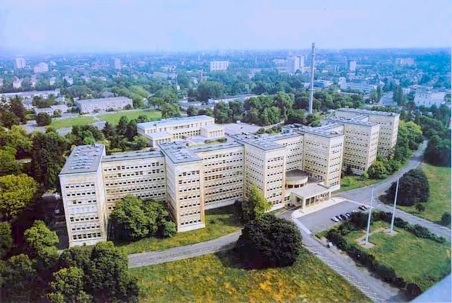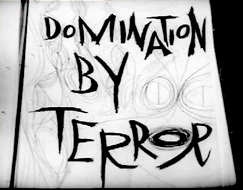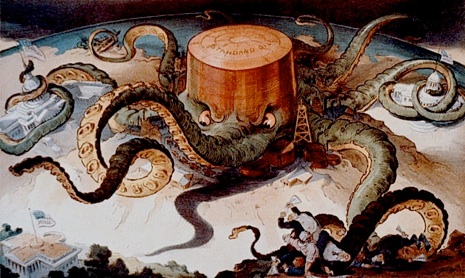Home > How the Nazis Won the War
The Cold War Revisited
or How the Nazis Won the War

The Cold War is a term used to describe the economic, political and military contest for influence in the developing world between the Capitalist West and the Communist East from 1946 until 1990. The postwar standoff can be seen as the continued playing out of the same unresolved conditions that had led to the rise of the Nazis leading up to World War II: namely, the opposition of the two unreconcilable ideologies, with the magnates of Western capital and captains of industry largely supporting Fascist defenders in the face of a perceived crisis in Germany—the threat of Communist revolution, spreading from the Soviet Union. The ideologically opposed US and USSR became unlikely allies after Germany’s declaration of war on the US (Dec. 11, 1941) —a bid to open a second front in the Pacific in its war on the Communist enemy (Jacques Pauwels). Once Germany’s defeat seemed inevitable a full year later, the US finally entered the war in the Atlantic theater, in the end checking Soviet momentum towards western Europe (and ultimately salvaging Nazi gains there*).
At the end of WWII, the US absorbed Germany’s scientists (Operation Paperclip), notably gaining V2 rocket technology for NASA; its spies, including the Gestapo’s anti-Soviet network, reactivated in a re-armed West Germany; and some ex-Nazi military top brass, integrated into NATO, with its seat (EUCOM) located in the unscathed IG Farben headquarters in Frankfurt.
IG Farben is the German name of the world’s biggest chemicals group of companies, or cartel, the industrial core of the Nazi war machine, supplying strategic war materials such as synthetic fuel and rubber, with a giant factory complex and its own concentration camp at Auschwitz. IG Farben companies also made pharmaceuticals, vaccines, explosives and poison gas, including the one used for exterminations in the Holocaust. Part of a global petrochemical cartel, IG’s commercial partner was the American Standard Oil Company, which for its part supplied the Reich with oil and vital fuel additives. Many of IG’s top executives were condemned for war crimes at Nuremberg. Standard Oil later changed its name to Exxon. After the war, the IG Farben cartel was disbanded into its constituent companies (Hoechst, now Sanofi-Aventis, Bayer, BASF) and its monumental headquarters building—spared from bombing—housed the American military government in Germany, CIA Europe and for many years, NATO Command, and became known as Europe’s Pentagon.
After their Allied victory, the two powers quickly fell out from their forced alliance amid an uneasy division of worldwide spheres of influence, and a military balance upset by the Americans’ atomic bombing of Japan at the close of the war, with Soviet troops on the doorstep. The USSR responded in 1949 with a demonstration of their own nuclear capability—an atomic test explosion, setting off the arms race.
The Cold War period was marked by the eventual, massive military buildups of nuclear weaponry by both sides—the US and the USSR, strained diplomatic relations, and regional interventions to maintain or increase zones of influence. The first important post-World War II disagreement between the Western bloc and the East was about the partition of defeated Nazi Germany, and led to a standoff, known as the Berlin crisis. With the western sector of the divided city blockaded, the western allies—the US France and UK—were forced to rely on air drops from 1948-49 to continue their military occupation there. Communication virtually ceased, and an "iron curtain" descended between the two superpowers, later symbolized by the Berlin Wall (1961). The U.S. consolidated its position in western Europe by launching a string of strategic actions, including the anticommunist Marshall Plan, the US-led North Atlantic Treaty Organization, or NATO in 1949, and an incremental series of regional pacts. *These agreements, negotiated through West Germany, would eventually culminate in the Brussels-based European Union—supra-national European integration, within the NATO area, on the anti-democratic legal model of Nazi Germany’s plans for rule over a conquered Europe (search: EU Commissioner Walter Hallstein). In the eastern half of Europe, the Soviet Union maintained control over the countries up to its own borders. In response to the formation of NATO, it instituted the Warsaw Treaty Organization in 1955.
The next military confrontation of the Cold War flared up on the divided Korean peninsula, where after Soviet withdrawal from the North, US forces remaining in the South clashed with the armies of North Korea and then newly Communist China in the Korean War, from 1950-53. The war ended in stalemate where it had begun, at the 38th parallel, leaving two million Korean dead.
The year 1957 saw the Soviet launch of the first intercontinental ballistic missile and the first artificial geospatial satellite, Sputnik, which kicked off the space race. The Soviets followed the feat with the first man in space in 1961. Exploiting the experience of its German rocket scientists, NASA engineered the Saturn rocket that would fly Americans to the moon.
In 1962 tensions between the two superpowers again mounted during the Cuban missile crisis when Cuba hosted Soviet missile installations in response to a failed US invasion of the country after popular revolution there. US President Kennedy negotiated a settlement that saw the missiles removed and the US pledged not to re-invade. He was assassinated in Dallas, Texas in 1963, just before the escalation of the war on Vietnam. The US went on to drop more tons of bombs on the rice farmers of Indochina than the total tonnage of all bombs dropped in all the war theaters of World War II.
Throughout the 1960s, the US pursued a combination of overt and covert war in the de-colonizing Third World. In fact, with its share of victory in Europe, it was replacing the old European imperial powers under a more subtle form of financial imperialism. But in Indonesia, Indochina, and Africa its wars to counter independent development claimed a total of over 5 million lives.
A combination of factors including China’s opening towards the US in 1972 ushered in a period of eased tensions between the US and USSR, known as détente, resulting in a series of arms control agreements. But the loss of Iran as its client state in the Iranian revolution of 1979 brought renewed US action in the Soviet sphere. First, in Afghanistan, seen as a replacement for Iran as an anti-Soviet base, the US engaged the Soviet Army with a well-armed proxy force drawn from its network of mercenary Muslim guerillas in a conflict lasting 10 years. Next, NATO and client Arab countries sponsored Iraq’s war on the newly independent Iran. The devastating, eight-year conflict claimed over one million casualties. Throughout this period—the 1980’s—the US carried out its first so-called ’war on terror’—covert wars on the Left in Latin America and targets in the ME; supported apartheid regimes; and escalated the arms race, with the Strategic Defense Initiative and revived Cold War rhetoric widening the gulf between the two superpowers.
The appearance of Mikhail Gorbachev as Soviet leader in 1985 saw a period of political liberalization which, gaining unstoppable momentum, eventually led to the breakup of the USSR and the Warsaw Pact in 1991, dramatically altering the international political landscape. Foregoing a peace dividend, Washington moved aggressively to fill the power vacuum on the strategic Eurasian continent, projecting its military to Russia’s borders with the expansion of NATO; into the former USSR with new bases negotiated in the Central Asian states; and to former Soviet satellites, with wars on Serbia and later Afghanistan. At the same time, US troops occupied the most resource-rich Middle Eastern countries, first client Saudi Arabia in the 1991 Gulf War and then Iraq in 2003. The occupations of Iraq and Afghanistan have resulted in a genocide of millions of Muslims, while creating tens of millions of refugees.
Under the banner of "Another World," emerging nations meanwhile have sought to re-organize a unification movement, the World Social Forum (WSF), replacing a co-opted Non-Aligned Movement, to achieve peaceful, independent development and finally defeat fascist terror.
This economic interpretation of history contradicts the conventional political view, of course. You have history as it’s written —not always the same as history as it happened. And later events, when added to the historical narrative, can help put the past into better perspective.
The orthodox view of this period including the war is that on one side you had the democracies—France, UK, US for example—and on the other Communist and Fascist dictatorships—who were initially aligned in the war. The Western democracies were aligned politically against fascist dictatorship and were joined by Russia only when it was attacked by Germany. The capitalist West somehow overcame its innate aversion to its mortal, ideological foe—the Communist East—to join with it. This last point constitutes a problem with this political interpretation.
To review the chronology leading up to the war...there were various prewar agreements between the different national powers. The Soviets in fact had been anti-Nazi from the beginning in 1933. Among the Western powers, you had a British naval agreement with Nazi Germany in 1935, and then the Munich agreement of Sept ’38 between the two. Stalin saw these pacts as a Western anticommunist reaction forming against the new USSR and for that reason made the German-Soviet pact as a defensive measure in 1939. For its part, Germany needed Soviet military neutrality to leave it free to fight on a single western front when it would later attack western Europe. But the Soviets were always going to be a target for the rabidly anticommunist Nazis. That was their program and that was what they were hired to do. So there was no question of an enduring alignment of Fascist and Communist dictatorship, along authoritarian political lines. But if you look at the pre-war economic prism, so to speak, you see the German Republic in danger of falling into the Communist camp, following Russia, through social revolution at home—an immediate threat to the 40% of foreign investment that had fled the cartel-busting US for Germany in the booming ’20s. Both German and Western private capital answered the revolutionary threat by financing the fringe Nazi Party to defend their economic interests, an alignment along economic lines. You have to distinguish public or government and private or corporate powers. You can certainly find examples of actions going at cross purposes while coming from the same side. This is a reflection of the two aspects of power, public and private, the latter showing itself to be the predominant influence, even within the public sector itself. Titans of American capital largely joined the cause in Germany which was billed as a Christian crusade (against godless Bolshevism). So the same interests that were targeting Communists in Europe (Bolshevik Jews) would have favored the overthrow of Communism in the Soviet Union, for the same ideological, ultimately economic reasons.
Now Britain and France were pledged to defend Poland so the Nazi invasion in Sept. 1939 resulted in their declarations of war on Germany, which had taken on ambitions to redraw imperial maps. The US was neutral for the first two years of the war. And even after Germany declared war on the US at the end of 1941, the Americans still stayed out of the Atlantic theater for a further year, while the Nazis continued their round-ups and attacked the Soviets. Once the tide started to turn against the Nazis with the pivotal Battle of Stalingrad, the US finally entered the war in the Atlantic theater, landing in North Africa in Nov. 1942. Even then, the US recognized Vichy there, with whom it had friendly diplomatic relations. It would be almost another year before US troops landed on the continent, in Italy, nearly four years after the war had started.
To end with a word on the EU. You can have a federal Europe but it would have to be by popular referendum and its executive would have to be elected. Its parliament would have to have lawmaking powers if you want to call it a democracy. That’s not what they have in the EU at Brussels and Strasbourg.
To recap...by the time dictatorship had fallen in the East in 1990, the US had formed one in the west of Europe, which then expanded east to Russia’s borders. As if Nazi Germany had been successful in Europe, minus the anti-Semitism, or with Muslims as the new scapegoats, and serial wars of aggression then continuing as part of a remade neo-fascism, operating on an audience of subjects agape at powerful modern media and cringing from the baton-blow shock on the collective psyche of mass shootings, disasters, profitable health scares and threats of more to come.

Certainly today the political debate is no longer about democracy versus dictatorship, unfortunately. In an irony of history, the West has taken on the totalitarian form of its erstwhile Cold War enemy, throwing out political freedom in favor of absolute economic tyranny, with the unchecked growth of private corporate power for over a century. But instead of dictatorship by the majority under Socialism, tracing its mandate to popular revolution, the Western decline into authoritarianism is a dictatorship by capital, which is just “arbitrary privilege” for an elite minority—the ancien regime (old order), transposed onto a financial hierarchy.
If the West has degenerated into a new form of fascist dictatorship, the East too has been remade with new kinds of state capitalism—a third way—offering economic freedom within a framework of state political control, exercised in the name of the majority, to correct the Western mistake and hold unaccountable private power in check.








